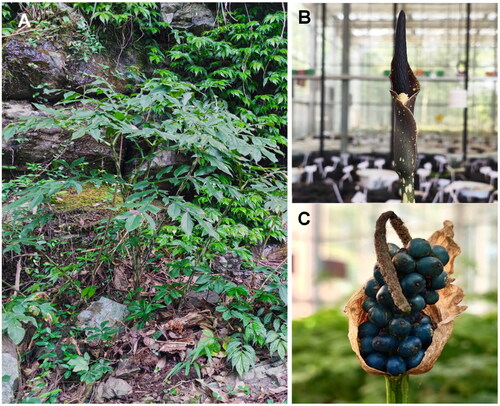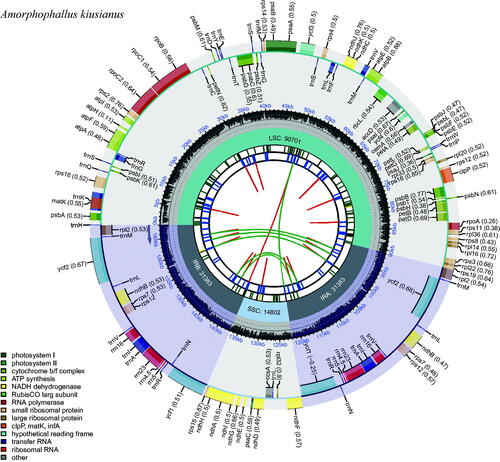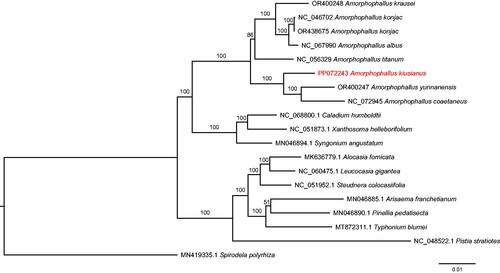Abstract
The mountainous region of southern China has been characterized by its complicated environment and topography. Amorphophallus kiusianus Makino 1913 is a representative species of extreme habitat preference that resides mainly in this region. To help study the genetic differentiation mechanisms of A. kiusianus populations, we sequenced the first chloroplast genome of this species using next-generation sequencing. The chloroplast genome was 166,269 bp in length with an average GC content of 36% (GenBank accession number: PP072243). The lengths of the large single-copy region (LSC), small single-copy region (SSC), and two inverted repeats (IRs) were 90,701 bp, 14,802 bp, 31,383 bp, and 31,383 bp, respectively. One hundred and twenty-nine genes were annotated in the chloroplast genome, including 84 protein-coding genes, 8 rRNA genes, and 37 tRNA genes. The phylogenetic tree suggested a close relationship among A. kiusianus, A. yunnanensis, and A. coaetaneus. The chloroplast genome reported in this study provides valuable genomic resources for the future phylogeographic research of A. kiusianus.
Introduction
Amorphophallus genus, a group of perennial plants in the Araceae family, is characterized by an underground stem and a solitary leaf () (Li et al. Citation2010). There are approximately 230 Amorphophallus species worldwide, mainly distributed in tropical and subtropical regions of West Africa and South Asia. In China, there are over 20 Amorphophallus species, making it one of the diversity centers of this genus (Srzednicki and Borompichaichartkul Citation2020). For the high content of glucomannan in the corm, several Amorphophallus species, such as A. konjac and A. albus, have been cultivated in China, Japan, and Southeast Asian countries for a long time (Srzednicki and Borompichaichartkul Citation2020). Amorphophallus kiusianus Makino 1913 is mainly distributed in mountainous areas of southern China, including Guangdong, Hunan, Jiangxi, Zhejiang, Fujian, and Taiwan provinces (Li et al. Citation2010). The natural habitat of this species is shaded environments with an altitude ranging from 300 m to 900 m, such as valleys, broad-leaved forests, plantations, and orchards.
Figure 1. Morphological characteristics of the leaf (a), flower (B), and fruits (C) of Amorphophallus kiusianus. The photos were taken by the author Yong Gao. The petiole of A. kiusianus is glossy with dirty olive-green or grayish-green colors. Spathe is dark greenish outside with small, whitish spots. The berries are at first bright green, turning pinkish purple, and finally deep blue.

For the complicated and diverse climate and topography, the mountainous region of southern China has been recognized as one of the world’s plant diversity centers (Sun et al. Citation2016; Gao et al. Citation2015). Due to the strict preference for altitude, the natural populations of A. kiusianus showed discontinuous distribution with small populations across southern China (Yin et al. Citation2022). However, the study on population genetic diversity and genetic differentiation of this species in isolated mountain systems has not been reported. The chloroplast genome is usually inherited uniparentally in flowering plants (Chen et al. Citation2018). For the low recombination rate and high transferability, chloroplast DNA sequences have been widely utilized in phylogenetic research, analyses of genetic diversity, and the development of DNA barcodes (Henriquez et al. Citation2020; Yin and Gao Citation2023b). In this study, we reported the first chloroplast genome, which will provide genomic resources for future phylogeographic studies of this species.
Materials and methods
One individual of Amorphophallus kiusianus was collected from Yichuan, Jiangxi province, China (115°23′31.6″ E, 28°57′45.3″ N). The specimen was deposited into the herbarium of the College of Biological Resource and Food Engineering, Qujing Normal University (JABF_6_Yinsi20220809, Yong Gao, [email protected]). Genomic DNA was isolated from 0.15 g of the fresh leaf material using a plant genomic DNA isolation kit (DP305; Tiangen, China). Novogene Bioinformatics Technology Co. Ltd (Tianjin, China) constructed the sequencing library and next-generation sequencing. Briefly, the DNA sample was first fragmented by sonication. DNA fragments with a size of approximately 350 bp were selected and ligated with adapters, followed by PCR amplification. At last, the DNA library was sequenced on the Novaseq 6000 platform with PE (paired-end) 150 strategy (Illumina, CA, USA).
The raw sequencing data of A. kiusianus was filtered to remove reads containing unidentified nucleotides or over 50% of low-quality bases (Pherd quality < 5). The chloroplast genome was assembled using GetOrganelle v1.7.8 (Jin et al. Citation2020). The assembling parameters were set as follows, the k-mers were set as 75, 95, 115, and 127, and the maximum extension rounds (R) were set to 40. The annotation of genome feathers was implemented with two online software, Cpgavas2 (http://47.96.249.172:16019/analyzer/home) and Geoseq (https://chlorobox.mpimp-golm.mpg.de/geseq.html) (Tillich et al. Citation2017; Shi et al. Citation2019). We manually adjusted the annotation result when necessary. The genome map of the chloroplast genome was drawn using the web-based software Cpgview (http://www.1kmpg.cn/cpgview/) (Liu et al. Citation2023). The quality of the assembly was assessed by mapping reads onto the genome using BWA v0.7.17 (Li and Durbin Citation2009). The cis-splicing and trans-splicing genes in the genome were analyzed by Cpgview (Liu et al. Citation2023). To infer the phylogenetic position of A. kiusianus, we downloaded chloroplast genome sequences of 18 Araceae species from the NCBI GenBank database. The genome sequences of these species were aligned using MAFFT v7.475 (Katoh and Standley Citation2013). ModelFinder was utilized to get the best nucleotide substitution model of the sequences (Kalyaanamoorthy et al. Citation2017). The maximum likelihood (ML) phylogeny among these species was constructed using IQ-TREE v1.6.12 with 1,000 bootstraps (Nguyen et al. Citation2015). The highly variable regions of the chloroplast genomes among A. kiusianus and the other six downloaded Amorphophallus species were analyzed using DnaSP v6.12 (Librado and Rozas Citation2009). The step size and window length were set to 125 bp and 500 bp, respectively.
Results
In total, 8.1 Gb of the raw sequencing data of A. kiusianus was produced using next-generation sequencing, and 5.38 × 107 clean reads were retained after filtering. The assembled chloroplast genome turned out to be 166,269 bp in length with an average GC content of 36%. We deposited the chloroplast genome sequence into the NCBI GenBank database with the accession number PP072243. A typical quadripartite structure was found in the genome, and the lengths of the large single-copy region (LSC), small single-copy region (SSC), and two inverted repeats (IRs) were 90,701 bp, 14,802 bp, 31,383 bp, and 31,383 bp, respectively (). The average coverage depth of sequencing reads across the genome was 320 (Figure S1). One hundred and twenty-nine genes were annotated across the chloroplast genome, including 84 protein-coding genes, 8 rRNA genes, and 37 tRNA genes. Eleven genes (atpF, ndhA, ndhB (two copies), petB, petD, rpl2 (two copies), rpoC1, accD, and rps16) were detected to have one intron, and four genes (clpP, rps12 (two copies), and ycf3) were found to have two introns (Figures S2 and S3). According to the Bayesian information criterion, ModelFinder suggested that the TVM + F+R3 model was the best nucleotide substitution model. The ML phylogenetic tree grouped all seven Amorphophallus species into one clade with a bootstrap value of 100, and a closer relationship among A. kiusianus, A. yunnanensis, and A. coaetaneus was suggested (). Based on a cutoff value of nucleotide diversity (π) > 0.04, we found eight highly variable regions across seven chloroplast genomes using DnaSP (Figure S4).
Figure 2. The circular map of the chloroplast genome of Amorphophallus kiusianus. Genes belonging to different functional groups are plotted in the outer circle. The quadripartite structure, which consists of the LSC, the SSC, and two IR regions, is shown. The dark gray in the inner circle indicates the GC content of the chloroplast genome.

Figure 3. Maximum-likelihood phylogenetic tree of Amorphophallus kiusianus and 18 other related taxa in the family Araceae. Spirodela polyrhiza is used as an outgroup. The scale bar represents the number of substitutions at each locus. Accession numbers: Amorphophallus kiusianus, PP072243 (this study); Amorphophallus krausei, OR400248 (Yin and Gao Citation2023b); Amorphophallus konjac, NC_046702 (Hu et al. Citation2019); Amorphophallus konjac, OR438675 (Li et al. Citation2024); Amorphophallus albus, NC_067990 (Shan et al. Citation2023); Amorphophallus titanium, NC_056329 (Henriquez et al. Citation2021); Amorphophallus yunnanensis, OR400247 (Yin and Gao Citation2023a); Amorphophallus coaetaneus, NC_072945 (Gao et al. Citation2023); Caladium humboldtii, NC068800 (reference not available); Xanthosoma helleborifolium, NC_051873 (reference not available); Syngonium angustatum, MN046894 (Henriquez et al. Citation2020); Alocasia fornicata, MN636779 (reference not available); Leucocasia gigantea, NC_060475 (reference not available); Steudnera colocasiifolia, NC_051952 (reference not available); Arisaema franchetianum, MN046885 (Henriquez et al. Citation2020); Pinellia pedatisecta, MN046890 (Henriquez et al. Citation2020); Typhonium blumei, MT872311 (Low et al. Citation2021); Pistia stratiotes, NC_048522 (Quan and Chen Citation2020); Spirodela polyrhiza, MN419335 (reference not available).

Discussion and conclusion
In this study, we sequenced and assembled the first chloroplast genome of A. kiusianus. A typical quadripartite structure and 129 genes had been found across the genome, which was consistent with the findings in chloroplast genomes of other Amorphophallus species (Li et al. Citation2024; Yin and Gao Citation2023a; Yin and Gao Citation2023b; Liu et al. Citation2019). Our phylogenetic tree based on chloroplast genomes indicated that Amorphophallus species distributed in East Asia formed two clades, which was in accordant with the previous study with LEAFY and trnL sequences (Grob et al. Citation2004). However, the support values of each branch were much higher, which suggested that the complete chloroplast genome was more effective than several gene sequences in inferring the phylogenetic relationship among and within species (Pouchon et al. Citation2023).
The mountainous region of Southern China is well-known for its complicated and fragmented geography and diverse environments (Qiu et al. Citation2011). As one species mainly distributed in this area, the natural populations of A. kiusianus provide an excellent material for investigating processes driving genetic differentiation. Our study provides valuable genomic resources for the future phylogeographic research of this species.
Ethical approval
This study includes no human, animal, or endangered plant samples, and the sampling site was not in the natural reserve. No permissions are needed during the collection of samples.
Author contributions
Si Yin designed the study. Yong Gao collected the sample, and Si Yin extracted the genomic DNA. Yong Gao and Si Yin analyzed the data. Yong Gao and Si Yin drafted the paper. The authors have approved the final version of the manuscript.
Supplemental Material
Download MS Word (560.1 KB)Disclosure statement
No potential conflict of interest was reported by the author(s).
Data availability statement
The chloroplast genome assembly of A. kiusianus is deposited into the NCBI GenBank database with accession number PP072243. The associated BioProject, BioSample, and SRA numbers are PRJNA1059772, SAMN39214234, and SRR27395334, respectively.
Additional information
Funding
References
- Chen X, Yang J, Yang Y, Zhang X, Du X, Zhao G. 2018. Characterization of the complete plastid genome of Castanopsis hainanensis Merrill. Conservation Genet Resour. 10(4):825–828. doi:10.1007/s12686-017-0940-9.
- Gao Y, Ai B, Kong H, Kang M, Huang H. 2015. Geographical pattern of isolation and diversification in karst habitat islands: a case study in the Primulina eburnea complex. J Biogeogr. 42(11):2131–2144. doi:10.1111/jbi.12576.
- Gao Y, Dong K, Xiao P, Wu W, Yin S. 2023. Complete assembly of the chloroplast genome of Amorphophallus coaetaneus S. Y. Liu & S. J. Wei 1986 (Araceae) from southwestern China. Mitochondrial DNA B Resour. 8(7):766–770. doi:10.1080/23802359.2023.2238939.
- Grob GBJ, Gravendeel B, Eurlings MCM. 2004. Potential phylogenetic utility of the nuclear FLORICAULA/LEAFY second intron: comparison with three chloroplast DNA regions in Amorphophallus (Araceae). Mol Phylogenet Evol. 30(1):13–23. doi:10.1016/s1055-7903(03)00183-0.
- Henriquez CL, Ahmed I, Carlsen MM, Zuluaga A, Croat TB, McKain MR, Abdullah. 2020. Evolutionary dynamics of chloroplast genomes in subfamily Aroideae (Araceae). Genomics. 112(3):2349–2360. doi:10.1016/j.ygeno.2020.01.006.
- Henriquez CL, Mehmood F, Hayat A, Sammad A, Waseem S, Waheed MT, Matthews PJ, Croat TB, Poczai P, Ahmed I, Abdullah. 2021. Chloroplast genome evolution in the Dracunculus clade (Aroideae, Araceae). Genomics. 113(1 Pt 1):183–192. doi:10.1016/j.ygeno.2020.12.016.
- Henriquez CL, Mehmood F, Shahzadi I, Ali Z, Waheed MT, Croat TB, Poczai P, Ahmed I, Abdullah. 2020. Comparison of chloroplast genomes among species of unisexual and bisexual clades of the monocot family Araceae. Plants. 9(6):737. doi:10.3390/plants9060737.
- Hu H, Liu J, Wang B, An J, Wang Q. 2019. Characterization of the complete chloroplast genome of Amorphophallus konjac (Araceae) and its phylogenetic analysis. Mitochondrial DNA Part B. 4(1):1658–1659. doi:10.1080/23802359.2019.1606683.
- Jin JJ, Yu WB, Yang JB, Song Y, dePamphilis CW, Yi TS, Li DZ. 2020. GetOrganelle: a fast and versatile toolkit for accurate de novo assembly of organelle genomes. Genome Biol. 21(1):241. doi:10.1186/s13059-020-02154-5.
- Kalyaanamoorthy S, Minh BQ, Wong T, Haeseler AV, Jermiin LS. 2017. ModelFinder: fast model selection for accurate phylogenetic estimates. Nat Methods. 14(6):587–589. doi:10.1038/nmeth.4285.
- Katoh K, Standley D. 2013. MAFFT multiple sequence alignment software version 7: improvements in performance and usability. Mol Biol Evol. 30(4):772–780. doi:10.1093/molbev/mst010.
- Librado P, Rozas J. 2009. DnaSP v5: a software for comprehensive analysis of DNA polymorphism data. Bioinformatics. 25(11):1451–1452. doi:10.1093/bioinformatics/btp187.
- Li H, Durbin R. 2009. Fast and accurate short read alignment with Burrows-Wheeler transform. Bioinformatics. 25(14):1754–1760. doi:10.1093/bioinformatics/btp324.
- Li L, Qi Y, Gao P, Yang S, Zhao Y, Guo J, Liu J, Huang F, Yu L. 2024. The complete chloroplast genome sequence of Amorphophallus konjac (Araceae) from Yunnan, China and its phylogenetic analysis in the family Araceae. Mitochondrial DNA B Resour. 9(1):41–45. doi:10.1080/23802359.2023.2300471.
- Liu S, Ni Y, Li J, Zhang X, Yang H, Chen H, Liu C. 2023. CPGView: a package for visualizing detailed chloroplast genome structures. Mol Ecol Resour. 23(3):694–704. doi:10.1111/1755-0998.13729.
- Liu E, Yang C, Liu J, Jin S, Harijati N, Hu Z, Diao Y, Zhao L. 2019. Comparative analysis of complete chloroplast genome sequences of four major Amorphophallus species. Sci Rep. 9(1):809. doi:10.1038/s41598-018-37456-z.
- Li H, Zhu G, Boyce PC, Jin M, Hetterscheid WLA, Bogner J, Jacobsen N. 2010. Araceae. Flora of China. Beijing: Science Press.
- Low SL, Yu C-C, Ooi IH, Eiadthong W, Galloway A, Zhou Z-K, Xing Y-W. 2021. Extensive Miocene speciation in and out of Indochina: the biogeographic history of Typhonium sensu stricto (Araceae) and its implication for the assembly of Indochina flora. J of Sytematics Evolution. 59(3):419–428. doi:10.1111/jse.12689.
- Nguyen LT, Schmidt HA, von Haeseler A, Minh BQ. 2015. IQ-TREE: a fast and effective stochastic algorithm for estimating maximum-likelihood phylogenies. Mol Biol Evol. 32(1):268–274. doi:10.1093/molbev/msu300.
- Pouchon C, Gauthier J, Pitteloud C, Claudel C, Alvarez N. 2023. Phylogenomic study of Amorphophallus (Alismatales; Araceae): When plastid DNA gene sequences help to resolve the backbone subgeneric delineation. J of Sytematics Evolution. 61(1):64–79. doi:10.1111/jse.12910.
- Qiu YX, Fu CX, Comes HP. 2011. Plant molecular phylogeography in China and adjacent regions: tracing the genetic imprints of Quaternary climate and environmental change in the world’s most diverse temperate flora. Mol Phylogenet Evol. 59(1):225–244. doi:10.1016/j.ympev.2011.01.012.
- Quan G, Chen L. 2020. Characterization of the complete chloroplast genome sequence of Pistia stratiotes (Araceae) and its phylogenetic implications. Mitochondrial DNA B Resour. 5(3):2168–2169. doi:10.1080/23802359.2020.1768935.
- Shan Y, Li J, Zhang X, Yu J. 2023. The complete mitochondrial genome of Amorphophallus albus and development of molecular markers for five Amorphophallus species based on mitochondrial DNA. Front Plant Sci. 14(1):1180417. doi:10.3389/fpls.2023.1180417.
- Shi L, Chen H, Jiang M, Wang L, Wu X, Huang L, Liu C. 2019. CPGAVAS2, an integrated plastome sequence annotator and analyzer. Nucleic Acids Res. 47(W1):W65–W73. doi:10.1093/nar/gkz345.
- Srzednicki G, Borompichaichartkul C. 2020. Konjac glucomannan-production, processing, and functional applications. Boca Raton: CRC Press.
- Sun Y, Surget-Groba Y, Gao S. 2016. Divergence maintained by climatic selection despite recurrent gene flow: a case study of Castanopsis carlesii (Fagaceae). Mol Ecol. 25(18):4580–4592. doi:10.1111/mec.13764.
- Tillich M, Lehwark P, Pellizzer T, Ulbricht-Jones ES, Fischer A, Bock R, Greiner S. 2017. GeSeq – versatile and accurate annotation of organelle genomes. Nucleic Acids Res. 45(W1):W6–W11. doi:10.1093/nar/gkx391.
- Yin S, Gao Y. 2023a. Characterization of the complete chloroplast genome assembly of Amorphophallus yunnanensis Engler, Pflanzenr (Araceae) from southwestern China. Mitochondrial DNA B Resour. 8(12):1445–1449. doi:10.1080/23802359.2023.2294896.
- Yin S, Gao Y. 2023b. The complete chloroplast genome assembly of Amorphophallus krausei Engler, Pflanzenr 1911 (Araceae) from southwestern China. Mitochondrial DNA B Resour. 8(12):1339–1342. doi:10.1080/23802359.2023.2288889.
- Yin S, Hao Z, Lu FD, Gao Y. 2023. Genetic diversity of six Amorphophallus species in Southwest China based on cpDNA sequences. Guihaia. 43(11):2055–2064. doi:10.11931/guihaia.gxzw202206048.
